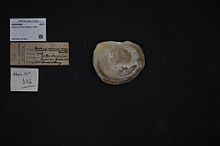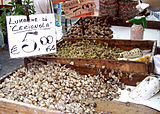Dredge oyster
| Dredge oyster | |
|---|---|

| |
| Museum specimen of the shell of Ostrea chilensis | |
| Scientific classification | |
| Kingdom: | Animalia |
| Phylum: | Mollusca |
| Class: | Bivalvia |
| Order: | Ostreida |
| Family: | Ostreidae |
| Genus: | Ostrea |
| Species: | O. chilensis
|
| Binomial name | |
| Ostrea chilensis | |
| Synonyms[1] | |
| |
The dredge oyster[2] or Bluff oyster,[3] Ostrea chilensis, known in Chile as ostra chilena, the Chilean oyster, is a species of marine bivalve mollusc in the family Ostreidae.
Distribution[]
This species is native to Chile and New Zealand.
Also, a self-sustaining population in the Menai Strait was deliberately introduced from the Fisheries Laboratory, Conwy, during the 1960s as an experiment to establish if they could form an alternative to the native oysters Ostrea edulis in fisheries, when the species was shown to be unsuitable because of low recruitment and vulnerability to parasites and pathogens the experiment was abandoned. O. chilensis has now spread to other areas of the Menai Strait and is regarded as an invasive species.[4]
Habitat[]
This bivalve is found from low tide to depths of up to 35 m.
Description[]
Its length is up to 105 mm, width up to 70 mm, and inflation up to 33 mm.
Commercial importance[]


In New Zealand, they are a prized delicacy, and harvested from March to August from the Foveaux Strait oyster fishery, which centres on the town of Bluff (hence the local name).[3] From the early 1980s, the fishery went into serious decline, due to the outbreak of an oyster parasite, Bonamia exitiosa, with the disease killing an estimated billion oysters between 2000 and 2003.[3] The population has been recovering since 2003, with fishermen voluntarily limiting the catch to half the allowable to aid the revival.[3][5]
Other[]
Changes in river flows in Southland, due to farming and especially power generation, carrying less limestone deposits into the Strait, is therefore believed to have caused an increase in susceptibility to Bonamia, as well as lower growth rates for some seasons in the past,[citation needed] but little evidence supports this and it seems only coincidental.[opinion]
References[]
- ^ Jump up to: a b "Ostrea chilensis Philippi, 1844". World Registry of Marine Species. Retrieved 1 January 2017.
- ^ "§2 Interpretation -- Fisheries Act 1996 No 88 as at 3 January 2013 -- New Zealand Legislation". Parliamentary Counsel Office. Retrieved 9 March 2013.
"dredge oyster" means the mollusc known as Tiostrea chilensis
- ^ Jump up to: a b c d "High demand for recession-proof oysters". New Zealand Herald. 2 March 2009. Retrieved 2009-03-02.
- ^ Eilir Hedd Morgan (2012). The invasion potential of the non-native Chilean oyster (Ostrea chilensis Philippi 1845) in the Menai Strait (North Wales, UK) : present observations and future predictions (Ph.D.). Prifysgol Bangor University.
- ^ H.J. Cranfield, A. Dunn, I.J. Doonan and K.P. Michael 2005. Bonamia exitiosa epizootic in Ostrea chilensis from Foveaux Strait, southern New Zealand between 1986 and 1992. ICES J. Mar. Sci. (2005) 62 (1): 3-13 doi:10.1016/j.icesjms.2004.06.021
External links[]
- Ostrea
- Molluscs of the Pacific Ocean
- Molluscs of Chile
- Bivalves of New Zealand
- Commercial molluscs
- New Zealand seafood
- Foveaux Strait
- Bivalves described in 1844
